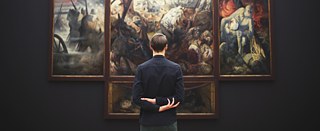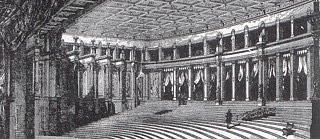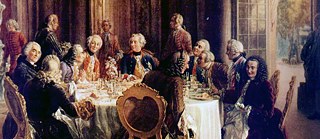The Elite in the Arts | An Essay by Hans Ulrich Gumbrecht
Resistors and the Special Case of Cultural Elites

Educational elites, business elites, scientific elites, political elites – the elite always seems to be a topic of conversation. But what does "the elite" – and the cultural elite in particular – actually look like? In trying to find a definition, literary scholar Hans Ulrich Gumbrecht encounters informal processes and privileges, exclusive rights, psychological power games – and the boundaries of social equality.

Elites and their Resistors
Certain groups of people are looked upon as “elites” because of their ability and often their claim to perform certain actions at a particularly high level of competence and effectiveness. Strictly speaking, the term refers only to active practice, not to relevant potentials or memories. Secondly, to speak of "elites" presupposes a hierarchy of values or prestige pertaining to certain actions and refers to its uppermost segments. To speak of an "elite of shop assistants and taxi drivers" sounds either too strained in its goodwill toward social equality or simply cynical. Thirdly, elites have institutional status, that is, specific expectations are placed on their members on which they may and must rely. While one can aspire to become part of an elite, an individually demanded or confirmed right to membership is so contradictory to its rules that such initiatives block access to elites. Finally, elite membership is valid only for the time being; it depends on continued validation through successful practice and may be lost through wrong decisions or long-term disappointment of expectations.
Different rules apply for the elites in various fields of practice. These rules define, above all, privileges of different elite groups having to do with their access to non-public information, decision-making authority, and levels of pay. Elite privileges, like the existence of elites in general, are justified and legitimized by expectations of efficiency. Captains of industry are in possession of information whose public circulation could trigger reactions of panic or precarious collective lethargy. Curators of galleries influence artists’ careers through their selection of works to be exhibited. And both supervisory boards of banks and museum directors negotiate salaries of extraordinary size that may be made plausible by the extraordinary importance of their activities.
“Elite,” however, has become an ambivalent term referring to an ambiguous range of phenomena. Contrary to the word’s etymology, which derives from the Latin verb eligere and from the French verb élire (both meaning "select"), elites arise in informal processes and of their own accord instead of going back to transparent rituals of collective decision, as do positions in politics and often in the legal system. While in a democratic polity it is open to any citizen to seek political or legal office, no formal path leads to membership in elites. For this reason, and certainly also because of the opportunities of some elite groups (in contrast to holders of government office) to acquire seemingly unlimited incomes, their very existence seems to many citizens like a violation of the principle of social equality. For the same reasons, elites constantly provoke suspicions of unjustified access.
In all societies, in fact, there is statistical evidence that seems to justify such protest and the ensuing reaction of resistance. For example, in the United States it can be shown that the representation of social minorities in the economic and political elites, especially the number of African Americans, Latinos, and even Catholics, lies far behind their percentage in the total population. In Germany, in turn, the stability of social hierarchies is a striking problem: the chances for social advancement of those born into a family with a low level of education and training are as low as the risks of downward social mobility for the children of academic and elite families.
Despite this convergence, a drastic difference separates the status of "elite" as a concept and an institution in the two countries. Joining an elite and getting infinitely rich remains at the heart of the American Dream, and it almost seems that the vivacity of the dream increases with the improbability of its realization. For example, many lower class families set up savings accounts after the birth of their children to pay for tuition to one of the legendary colleges that present themselves as a decisive step on the pathway to joining the elite. The colleges, for their part, have now developed generous scholarship systems so that they will not miss out on promising talents for financial reasons.
The same yearning and elitist ambitions may also exist on the individual level in Germany, but there the very word is taboo, because in Europe the norm of equality, an equality that goes beyond equality before the law, has gained much wider scope and importance. The usual discussions in Germany about the moral justification of maximum salaries would be inconceivable in the United States, while on the other hand it surprises Americans to hear that the strength of the German university system is reflected not in international top rankings but in solid consistency of quality.

King Frederick II Tableround in Sanssouci | © Adolph von Menzel creator QS:P170,Q164961, Adolph-von-Menzel-Tafelrunde2, bearbeitet, CC BY 4.0
What distinguishes elites in culture and the arts may be the impossibility of assessing quality and performance in this dimension of society according to quantitative or conceptually incisive criteria, as Immanuel Kant noted in his Critique of Judgment. From this the paradoxical consequence may have arisen that in nothing else does the self-certainty of the elite, its hierarchical distance from those who do not belong to it, and even its elevated social prestige, appear more clearly. It is only in the fields of art and culture that appreciation of the greatest practitioners yields a secondary elite effect for their admirers.
Moreover, only here does the usual skepticism about the most visible leading figures and the reservations about their income seem to have been largely suspended. Even in Germany there is no debate about the high double-digit millions that Gerhard Richter has earned with some of his works, and although the fees pocketed by stars of the classical music scene (for example at the Bayreuth Festival) would, in Europe at least, be impossible without public subsidies – that is, without using taxpayer’s money – to push for disclosure of fee amounts or question their justification is, in contrast to the case of leading economists or professional athletes, looked upon as bad taste.
Really remarkable financial privileges, however, are enjoyed today only by a small group of visual artists. What connects them with other members of the international art elite is access to a few theaters, art galleries and other public spaces that links them with their elite public and gives them a normative effect on younger generations. Anyone exhibiting at the Venice Biennale, singing at the Salzburg Festival or performing as a soloist with the Berlin Philharmonic belongs to the elite in the arts and acquires influence over the rise or fall of colleagues. No other elite is similarly fixated on its exclusivity, and equally successful in preserving it.
In recent decades, in reaction to a phase of openness since the late sixties of the twentieth century, conjured up by socio-pedagogical and sometimes even socio-revolutionary arguments, when, for example, the concept of "popular literature" underwent the beginnings of a revaluation or repeal among literary scholars, the narrowness of the elitist production and reception of objects of aesthetic experience has again become attractive. One relevant symptom is the growing prominence of the role of the curator, which presupposes that even an elite public is constantly in need of extended specialist knowledge as a condition of its access to elite art.
Under such conditions, signs of popularity jeopardize the prestige of outstanding artists and authors. It was undoubtedly the broad success of Pablo Picasso’s paintings and Gabriel García Márquez’s novels that aroused skepticism about the importance of their work among the most demanding public. Conversely, only in exceptional cases has an artist or an art form risen from popular beginnings to the elite. The most impressive example from the recent past is the history of jazz, from its origins in the African-American south, via Chicago and also New York, to worldwide resonance after World War II. In the meantime, however, this musical form has long since fallen prey to the exclusive tendencies of the art elite. The number of its followers and the degree of their refinement of taste may today correspond to that of aficionados of atonal music.
It is, after all, probably no coincidence that the singular rise of jazz took place in the United States. There too, of course, especially in the cultural centers of the East Coast and among their educational elites, one may observe a will to exclusivity. But unlike in Europe, the progress of this exclusivity cannot, on constitutional grounds, be financed by the state. That may explain why popular successes on Broadway still lead to Hollywood studios, and why Academy Awards and even financial success hardly tarnish the prestige of actors or directors.
By contrast, the days when politicians and their parties wanted to exploit the fascination of art have long passed, and “committed” art or literature has long since been covered by an unmistakable patina of the historical. Today the state tends to remain nobly anonymous in its promotion of elite art. Conversely, Oscar winners are particularly eager to use their reputation and their public as a platform to resonate their personal views on politics.
To the Overview